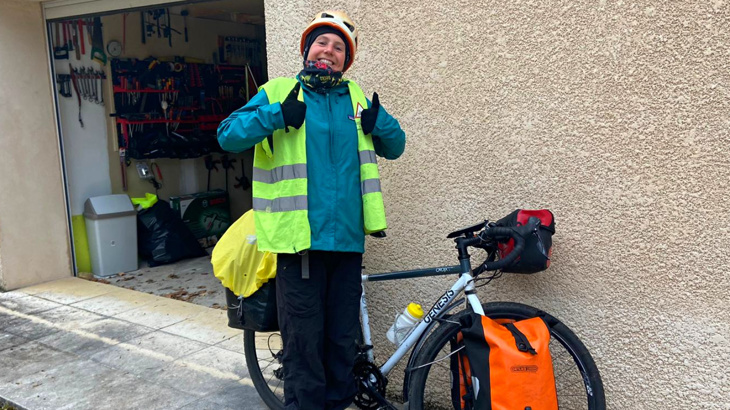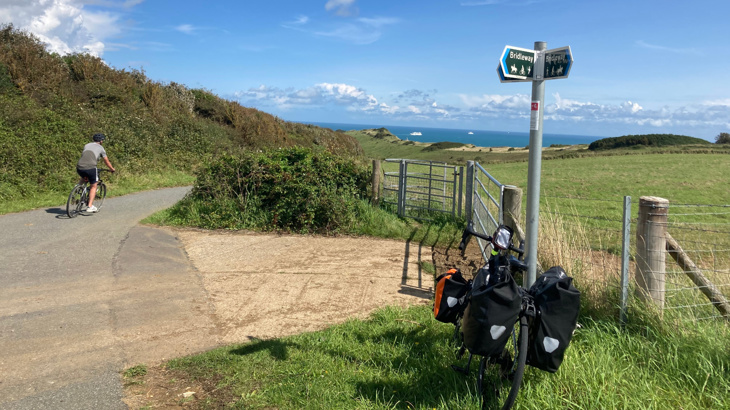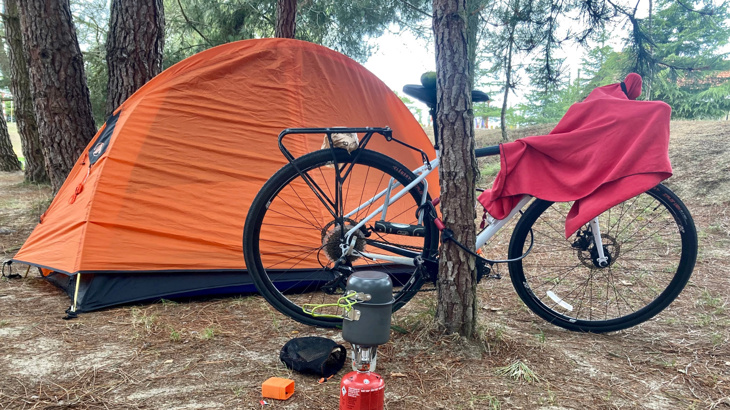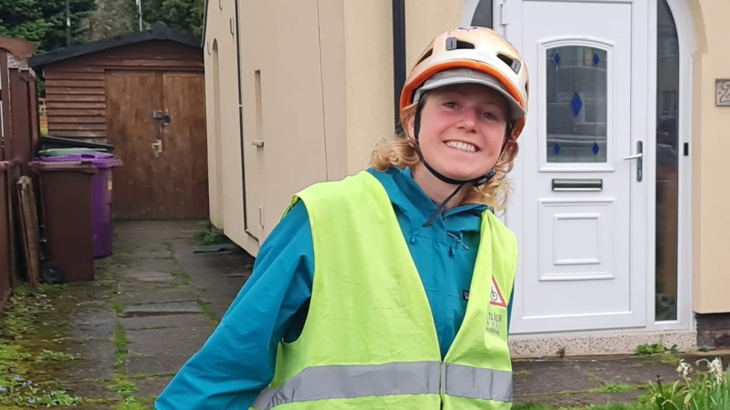Ever thought about embarking on a solo bikepacking trip? In this blog, Isobel talks about her experience of cycling across the UK using the National Cycle Network as a solo female traveller. She shares her top tips for touring on a budget, her favourite traffic-free routes on the Network, and talks about the warmth she found in people along the way.

Isobel went on a solo cycle tour through Turkey, Greece, Italy, France, Belgium, and back to England where she travelled on the National Cycle Network. Credit: Isobel Duxfield
Exploring the UK's National Cycle Network by bike
“Not again” I groaned as my feet plunged into the floodwaters which swamped the Warwickshire roads.
I pedalled frantically in an attempt to remain upright, but promptly veered sideways, tumbling knee deep in the deluge which, after months of torrential downpour, was commonplace across the entire country.
This was not my first time cycling through flooding, and it would not be the last; in fact, I could not remember the last time my feet had been dry.
Ok, so this introduction may not paint a glowing picture of pedal power, but stay with me.
April showers aside (which this year appear to have lasted six months), the United Kingdom is a fantastic place to cycle.
The small windy roads, undulating hills and meandering rivers provide beautiful scenery for those looking for adventure.
The UK has been pelted with rain over the past few months, and sometimes it has felt like it will never stop.
As the clouds (finally) begin to part, many of us are again itching to get outdoors.
What better way to travel than by cycling, wheeling and walking?
The Network: a nexus of interconnected routes
Locating a suitable route is often difficult.
On countless occasions I have found myself on congested arterial roads or marshy footpaths, lamenting my failure to thoroughly consult the map beforehand.
This is where the National Cycle Network comes in.
For those unfamiliar with the Network, it is a nexus of interconnected routes, marked by signs, which snake across the British Isles.
They direct riders over less-congested (often traffic-free), more scenic options, passing through historic towns, national parkland and stunning coastlines.
I have just returned from a solo-cycling tour which took me from Turkey, through Greece, Italy, France and Belgium, and back to England.
Alighting from the ferry at Dover, cruising (perhaps not an accurate word for my dawdle) across the white cliffs, I realised how little I knew about cycling back home.
I set out to travel around the UK using the National Cycle Network.
Across three weeks I followed the Network’s blue signage over steep coastal paths (many dedicated to cycling and walking), traversed flat fenland in Cambridgeshire (beware of the wind), repurposed railway lines in Oxfordshire and Staffordshire, Birmingham’s canal towpaths, and the tiny back lanes of North Wales (remember your raincoat here).
It's an opportunity to experience Britain’s most spectacular landscapes and wildlife, which, if navigating via car, you would not have access to.
Indeed, while pedalling the coastal routes (such as between Dover and Folkestone, or Llandudno and Bangor), I (almost) felt sorry for the car passengers confined behind concrete walls, unable to witness the sea birds, beautiful cliffs and lapping waves which I was privy to.
Awash with quaint villages, these routes are also ideal for those who want to take regular rests.
I visited numerous cafes and pubs, sharing interesting conversations with locals who offered advice on places to see and activities to do.
The generosity and warmth with which most people greet you when travelling by bike is astounding.

Isobel said the National Cycle Network 'directs riders over less-congested (often traffic-free), more scenic options, passing through historic towns, national parkland and stunning coastlines.' Credit: Isobel Duxfield
The road towards cycling for everybody
Despite spending months in the saddle, I am no cycling sage. I have only just learned how to fix a puncture, I am flummoxed by most mapping software, I have never used clip-in shoes and (shock, horror), I am not even on Strava.
During my tour I have frequently relied on the kindness and support of many strangers who advised on directions, aided with mechanical issues and provided constant encouragement.
Luckily for me, you do not need to be an expert to take on one of the Network’s routes.
Experienced riders on multi-day trips, families introducing children to cycling, or even those trying this mode of travel for the first time, the Network caters for all, and the choice is endless.
The recent reinforcement of the National Cycling Network is part of a seismic shift in accessible active travel infrastructure we are witnessing in the UK.
In the current fractious urban mobility climate, change often feels lethargic, if not regressive.
Yet, from London to Manchester, Glasgow to Bristol; cycle lanes, bike parking and even pop-up mechanics courses, are making cycling safer and more accessible than ever before.
Nonetheless, cycling infrastructure is not simply there to service the daily commute from A to B; it is about the joy of movement and freedom.
The National Cycle Network plays a pivotal role here, helping everybody- whatever cycling prowess- to experience cycling as a form of leisure, not just functionality.
As we look to decarbonise recreational - as well as commuter - travel in pursuit of climate targets, making active travel as accessible as possible will be increasingly important.

Throughout Isobel's three-week trip she used a combination of accommodation from camping to Warmshowers. Credit: Isobel Duxfield
Cycling solo, staying safe
Unlike many embarking on a cycling trip, I chose to go it alone.
In the UK, men take more than three times the number of cycling trips than women, and cycle over three times the distance; therefore, a woman cycle touring solo attracts a lot of attention, even in places where bike travel is commonplace.
Indeed, multiple times a day I would be asked: “Are you sure this is safe? Aren't you scared?”
From a young age, girls are taught to be wary of - even fear - travelling alone.
Don’t take the back-alley route home, don’t wait at the bus stop, and if you must go out after dark, keep your mother on speed-dial and grip your keys firmly between your fingers for maximum defence.
These are not irrational responses to our surroundings.
As women, we have learned (the hard way) countless times the consequences of taking our eyes off the ball - or to put it more bluntly, attempting to navigate public space like our male counterparts.
I would be lying if I suggested there were never moments of fear during my tour; nonetheless, there were only a handful of moments when I questioned my safety, and these were dwarfed by the unparalleled warmth, generosity and continued encouragement I received.
This is not to dismiss the very real threats women face.
British Transport Police’s figures from 2023 suggest over one-third of women have experienced sexual harassment while using public transport.
Nonetheless, I found comments about my gender incredibly irksome, and mostly, I just wanted to be accepted like any other cycle tourer on the road, equally as experienced and equally as capable as my male peers.
As more women, and other minorities within cycling, make themselves seen and heard, we will cease regarding women cycling alone as a curiosity.
Sustrans' Walking and Cycling Index (2023) found that more than twice as many men (21%) cycle more than once a week than women (10%).
The Walking and Cycling Index (formerly named Bike Life) is the biggest assessment of walking, wheeling[1] and cycling in urban areas in the UK and Ireland.
It is the clearest picture of walking, wheeling and cycling across the country.
Touring on a budget
Multi-day tours are becoming ever more popular as long-distance cycling infrastructure improves.
Over the last few years, an expanding EuroVelo network, improved bicycle capacity on train lines, as well as innovative and accessible mapping technology and bike products are luring more and more into the world of cycle touring.
Unfortunately, for many, the perceived expense of long-distance bike travel is a major deterrent.
Good quality bikes, durable panniers, GPS technology, overnight accommodation - it all seems to add up.
However, there are many ways to minimise costs. For example, a range of applications and forums have been established to support cycle tourers - and other travellers - to find cheap and free accommodation, with CouchSurfing and Warmshowers perhaps the most popular sites today.
For those unfamiliar with these sites, the basic premise is a 'host' can list their home as a potential location for travellers to stay, with 'guests' (or 'surfers' as Couchsurfing terms them) then able to request to stay.
While CouchSurfing is open to all, Warmshowers is reserved for those travelling by cycle, and has grown over the last decade to now boast over 100,000 users worldwide.
Along the way I used these often, receiving incredible kindness from many individuals who hosted me in spare rooms, on couches or allowed me to pitch my tent in their garden.
I am just one of many who travel like this, and, as I discovered, across the globe there is an entire network of generous and open individuals who welcome total strangers into their homes, sharing shelter, food and wonderful conversation.
There are also a range of websites and forums offering cheap second-hand cycling kit.
I regularly make use of platforms like eBay and Facebook Marketplace, where there are many bargains to be had.
In fact, my panniers are second-hand, purchased a decade ago, and are still in excellent condition, despite being dragged through Alpine hedges, Albanian dirt tracks and Turkish snowstorms.
Cycling and wheeling for everyone
“This all sounds great, but I am not a cyclist”, I hear you say.
If I have learned one thing from my journey, it is that a ‘cyclist’ is not defined by the brand of their lycra, weight of their bicycle or their top speed; if this were the case, you could count me out too.
Carbon fibre racers, recumbents, tandems, bikes pulling trailers, electric models, I have come across them all while on my tour; each enjoying cycling and wheeling their own way.
There is however one thing that unites them all, none requires a car to experience the great outdoors.

'If I have learned one thing from my journey, it is that a ‘cyclist’ is not defined by the brand of their lycra, weight of their bicycle or their top speed; if this were the case, you could count me out too.'/ Credit: Isobel Duxfield
My top tips for a cycle tour
- Remember to take a map (digital or physical) with you too. The Network’s signage provides good direction, but navigation also requires additional mapping, particularly to understand the elevation and plan accordingly.
- Trains are a good way to transport your cycle, and bike spaces are free on British trains. However, check with the operator first, as some lines require advance booking for bicycles. Platforms such as Trainline also offer cheaper tickets, which can dramatically reduce the cost of any trip.
- Be prepared for obstacles on the route. Many paths, particularly those adjacent to canals and rivers, have multiple obstructions such as gates and steep bridges; these may not be suitable for recumbent bikes or trailers - or those looking to fly along at 25kmph. Sustrans’ guide provides further advice for traversing these barriers.
- Plan for rough(er) terrain along some sections of your journey. Many of the routes direct you along unpathed paths, and thus may require additional caution, particularly for young children or bicycles with thin tyres.
- Stay seen. It is pivotal to make oneself as visible as possible when cycling. I wear a hi-vis jacket and place a fluorescent cover on my panniers to alert drivers to my presence.
- Yes she can. For women cycling alone or looking to get started, there are many women’s cycling clubs which provide help and advice, as well as several individuals on social media who are cycling solo and provide great inspiration.
A few of my favourite sections of the Network
- Route 2: Dover to Folkestone. This route takes you along the coast, via dedicated cycling and walking paths, down into Folkestone and along the flat seafront. There are fantastic views and plenty of places to buy food and drink, as well as take a swim in the sea. Trains to Dover from London allow bikes and cheaper tickets are often available in advance, making it an affordable trip for those with young families.
- Route 57: Oxford to London. This is approximately 100km, but train stations are available all along the route if required. It takes you along the Phoenix Trail (an old trainline) and over the Chiltern hills. The elevation is not too strenuous and it passes through multiple wooded sections.
- Routes 5 and 55: Stafford to Manchester. This flat route is largely traffic-free, and is perfect for experiencing England’s historic canals. It also follows an old railway line which provides wonderful views of the surrounding hills.
- Route 18: Ashford to Tunbridge Wells. For those seeking a few more hills, this section meanders across Kent, through lovely backroads and forests. There are several small villages to stop at, and good train connections are available at each end of the route.
- Route 6 and 67: Castleton to Sheffield. The Peak District offers some incredible scenery, however finding a good cycling route can be complex as it is often busy, particularly at the weekend. This is a good option for those seeking to avoid the traffic and steep hills. From Sheffield there are also many fantastic routes heading north and eastwards.
- Routes 77 (Salmon Run) and 7: Perth to the Cairngorms. Scotland is a Mecca for cycle tourers around the world, and this route is a fantastic option for travelling northwards while avoiding major roads like the A9.
Note to reader
Sustrans recognises that some people who use wheeled mobility aids, for example a wheelchair or a mobility scooter, may not identify with the term walking and may prefer to use the term wheeling. We use the terms walking and wheeling together to ensure we are as inclusive as possible.





